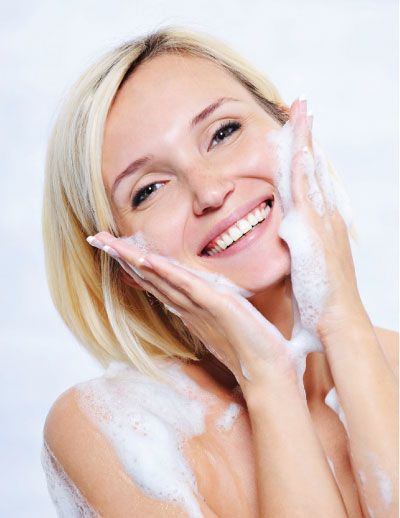Restoring health and balance to sensitized skin must begin with a basic clarification of terms. If your client complains of tight, red, stinging, itchy, reactive, flushing, blushing, or hot skin, she may describe her skin as “sensitive.” In fact, an estimated 50 percent of our global industry’s skin care clients describe their skin in this way.
The customer is always right, but in this case, most of them are wrong. Sensitive skin is inherited. Sensitized skin is acquired. The behaviors of the two conditions are often similar, and treatments may be similar as well. But here is the crucial difference: If you truly have genetically inherited sensitive skin, then the tendency is innate and cannot be fully erased but it can be treated. It is in your DNA! But here is the good news! Sensitization is a response to an external or introduced factor (or combination of these factors). It is not driven by genetics. Generally, it is triggered by lifestyle choices (including too much stress) or exposure to environmental chemicals. So it is possible that sensitization may be arrested, moderated, and fully reversed with changes in environment, habits, etcetera.
What Does Sensitization Look and Feel Like?
The primary signs of sensitization indicate that the lipid epidermal barrier has been compromised. Examine your client’s skin through sight and touch for:
- Thinned texture, translucent appearance
- Dehydration on the cheek and forehead area
- Excessive dryness, uneven texture, and rough patches
- Tightness after washing, and stinging on product application – or even simply when rinsing with water
- Broken capillaries across cheeks and nose
- Erythema (redness) on cheeks, décolleté and neck, or all over
- “Hot spots”, especially on the décolleté, neck, and cheeks
- Blushing and itching, burning sensations
- Small, rash-like bumps or breakouts
Why is it Important to Treat Sensitization?
Dealing effectively with sensitization is not just about “another pretty face.” These symptoms are not only unattractive, uncomfortable, and possibly painful for the client, but also can be viewed as warnings of more significant risk and damage. Remember that the skin is the first line of defense against pathogens. Clients tend to view their skin concerns as “aesthetic,” but in fact our skin is a living shield which protects our tissues and organs from infection. A damaged lipid barrier can no longer offer this level of needed protection. With this in mind, the client should be encouraged to embrace treatments and practices which will slow this destructive cascade of symptoms.
What Causes Sensitization?
There are two primary processes that contribute to sensitized skin. While visibly red, irritated skin may be the end result of two different types of inflammation – immunogenic and neurogenic – one can also have these types of inflammation without visible signs (e.g. redness) associated. The inflammatory process is still occurring but it is invisible to the eye and may only result in stinging, burning, and/or itching. In this case the skin is sensitized. If not controlled it may lead to visible inflammation associated with redness and the typical symptoms.
- Immunogenic Inflammation is defined as the body, in this case, the skin, responding to an introduced irritant (pollen, bacteria, and artificial fragrances are common triggers) with an immune system response. In other words, the skin attacks the intruding force as though it is a pathogen which must be eradicated from the body, much the way your body would fight off a rhinovirus which causes the common cold, etcetera. However, in the case of sensitization, pain, redness, and swelling are common responses.
- Neurogenic Inflammation originates in the nerves, and nervous system. Chemicals and pollutants in the environment stimulate receptors in the skin to trigger inflammation resulting in the release of substances called neuropeptides that trigger the inflammatory response. Under normal conditions, these substances play a highly useful role in tissue repair (e.g. wound healing). However, neuropeptides also are active in triggering and aggravating sensitization as well as a variety of painful inflammatory conditions such as urticaria (itching), psoriasis, atopic dermatitis, and rosacea.
Combine either or both of these factors above with a compromised barrier lipid layer and you have the perfect conditions to have inflamed overly reactive skin that triggers either or both of these two complex processes. The simplest answer is “stress” – defined any number of ways:
- Interpersonal mental/emotional “life” stress – challenges with family, work, finances, other social or relationship-oriented interactions
- Sheer physical stress caused by fatigue, systemic dehydration or malnutrition, or literal metabolic exhaustion or overexertion—from extended travel, rigorous activity or athletic training, or recovery from illness
- Stress of an environmental variety, such as the immune system being challenged by toxins in the air, water, or other physical conditions.
These environmental and lifestyle factors contribute greatly to sensitization, so it is vital to question and coach your client thoroughly about:
- Extremes of climate, both interior and exterior, natural/manmade
- Smoking, which dehydrates the skin by depleting barrier lipids and affects collagen synthesis and cell metabolism
- Exposure to pollution – not just smog, but think in terms of “sick building syndrome,” chemicals encountered in the workplace, etcetera. Even the fumes from a new carpet, new furniture (which often is stabilized with formaldehyde) may trigger sensitization
- Excessive exfoliation leading to over-processed skin, especially combinations of common procedures and products such as microdermabrasion, glycolic peels, retinoids, etcetera
- Laser resurfacing or other trauma to the skin
- Excessive washing, especially with alkaline products like conventional bar-soap, and especially showering/bathing in too-hot water. Remind clients that skin prefers gently warm/tepid versus steaming-hot
- Topical products and makeup containing artificial fragrances, colorants (D&C or FD&C colors), and SD alcohol Alcohol and caffeine consumption, can dehydrate the tissues and in some clients dilate capillaries, resulting in flushing and redness
- Inadequate UV protection; oftentimes chemical sunscreens (non titanium dioxide or zinc oxide sunscreens) can trigger sensitization
- Nutritional choices: check into habits such as diet pills (see caffeine comment, above) and low-fat diets which may deplete lipid strength. Also, eating spicy foods has been linked to increased skin sensitivity, possibly due to nerve activity in the skin
- Stress and sleep-deprivation
 Treatment Strategies: Where to Begin?
Treatment Strategies: Where to Begin?
The first step in breaking the cycle of sensitization is removing as many triggers from the contact-sphere as possible. Lifestyle choices which are under the client’s control are an obvious place to start, such as smoking, alcohol, and caffeine consumption. Likewise, stress may be managed to some degree through other lifestyle choices, such as the decision to exercise, pursue meditation, receive alternative therapies, massages, etcetera.
The other aspect of environmental sensitization over which we all have less – if any control – is the presence of irritants in our environment. These irritants may be natural, like pollen, but most are man-made. These are in our world whether we want them there or not. Dealing with the effects of these chemicals upon the skin requires a regimen of care based around ingredients which arrest inflammation and restore damaged tissue.
Cleansing the skin properly is the first step in strategic care. As mentioned, alkaline soaps and hot water set sensitization into motion. Clients need to use an extremely gentle, sulfate-free, non-stripping gel or cream cleanser which will fortify the protective barrier function without leaving a residue. If the client is sensitized to water, the product may also be removed with damp cotton or a soft cloth. Ingredients to look for in this type of cleanser, which also is appropriate for newly resurfaced skin, include raspberry, a rich source of phytochemicals including ellagic acid that acts as an antioxidant, soothing cucumber, and panthenol (provitamin B5) that helps to regenerate tissues.
A spritz of calming spray is a recommended next step. Look for a soothing, hydrating mist to immediately relieve irritation—this sort of product may be used by the client throughout the day at times of irritation. The newest and most effective formulas now contain cocktails of not only anti-inflammatory agents such as avena sativa, but ingredients to fight neurogenic inflammation, such as red hogweed. Oat extract is rich in oat avenanthramides which are the active fractions of oat that have been widely studied and proven to have natural anti-irritant and anti-redness properties, ginger and bisabolol (derived from chamomile) when combined work synergistically to reduce inflammation-induced itch, redness, and irritation. Combine this with red hogweed which targets neurogenic inflammation by limiting the production of pro-inflammatory agents (such as prostaglandins) and you have a complete system to target inflammation.
Masks are especially helpful to the sensitized client, since the prolonged contact of a calming relief mask product with the skin delivers lasting effects. Typically, an appropriate mask of this type may be applied to spot-areas, or to the entire face, either for flare-ups as emergency relief, or for regular therapeutic use. Key ingredients to select include pharmaceutical grade colloidal oatmeal, red hogweed, mushroom (cordyceps sinesis) extracts that reduce short and long term inflammation and redness. Mugwort (artemesia vulgaris) and algae extracts soothe irritation, and provide a light film to reduce redness from UV exposure and chemical irritants.
Serum concentrates speed the healing process at times of severe inflammation (even post- cosmetic medical procedures) and ease the discomfort of long-term sensitization. A concentrated booster can be the needed “brakes” on runaway inflammation. Look for serums containing the latest newcomer Acetyl Tetrapeptide-15 a peptide that reduces discomfort and pain by lowering pro-inflammatory mediators in the skin that are associated with neurogenic inflammation. To reinforce the barrier lipid layer that keep environmental chemicals from penetrating the skin: Portulaca oleraca extract lipids, sunflower seed, evening primrose, and avocado oils are also recommended.
Appropriate moisturizer and UV protection are also essential to managing sensitization, since dehydration, excess heat, and free radical damage often are syndrome triggers. Sensitization clients who are fond of exfoliating may use an ultra-gentle exfoliant, only on the condition that the lipid barrier is not damaged. In this case, recommend an ultrafine product that delicately polishes fragile skin. Also note that even conventional washcloths and towels can irritate sensitized skin; recommend that the client use a high-tech microfiber sponge cloth for cleanser and mask removal.
In terms of moisturizers, often a rich, medium-to-heavy weight product works best, to form a substantial layer of lipid barrier protection and humectant hydration around tenderized areas like cheeks, nostrils, cuticles, or any other hot spots. UV daylight defense product should be a physical block rather than a chemical sunscreen. Monitor this usage carefully, as sun protection often is a trigger for inflammation among sensitized clients.
Professional treatments for sensitized skin must always emphasize suppression of the inflammation cascade. The hallmark of this approach is the “less” rule: less aggressive, less intrusive, less product, gentle temperatures, gentle touch. Use warm steam at least an arm’s length from the body, rehydrate and infuse soothing complexes on the skin with a Dr. Lucas Pulverizator, and always have cool towels on hand. Manual lymphatic drainage, pressure-point work, and aromatherapy often prove invaluable in calming the client’s reactive responses.
Beyond the Skin to the Soul
The Internet and the self-help aisle of every bookstore bulge with information and advice about stress-management and well-being. As a skin therapist, we must take care not to overstep our expertise. It is appropriate, however, to discuss with your client the relationship between a person’s overall level of satisfaction with life – the oft-elusive “joy” factor– and the way the body responds to attack, trauma, and stress.
Never preach. Should you dispense marital advice, or tell your client to quit smoking, eat more veggies, or lose that belly-fat? Absolutely not. However, in your skin analysis and questioning sessions, it is reasonable to discuss the need for coping skills like time-management and prioritization. Just do it without sermonizing.
To support your hands-on treatment of sensitized skin, consider forming a partnership with a nutritionist, meditation leader, life-coach, or other wellness professional in your community, and discuss referrals through offering free group sessions for interested clients. Sessions such as this invariably generate paying business for the other partnership professional. Clients’ skin will thank you – and you will reinforce your own professional relationships with them by enriching their lives.
 Annet King is the Director of Training and Development for the International Dermal Institute (IDI). Her responsibilities include overseeing the IDI teaching staff around the globe, as well as developing the curriculum taught in all 43 countries. Beginning her career as a skin therapist for a day spa in England, she was quickly promoted to Operations Manager. King then became a skin therapy and business lecturer at Plymouth College of Further Education, where she realized her true passion for teaching. Her next position was as a Spa Director for Steiner Leisure, managing luxury spas onboard cruise ships. She is a licensed skin care therapist, certified by CIDESCO and CIBTAC, an instructor, and industry author.
Annet King is the Director of Training and Development for the International Dermal Institute (IDI). Her responsibilities include overseeing the IDI teaching staff around the globe, as well as developing the curriculum taught in all 43 countries. Beginning her career as a skin therapist for a day spa in England, she was quickly promoted to Operations Manager. King then became a skin therapy and business lecturer at Plymouth College of Further Education, where she realized her true passion for teaching. Her next position was as a Spa Director for Steiner Leisure, managing luxury spas onboard cruise ships. She is a licensed skin care therapist, certified by CIDESCO and CIBTAC, an instructor, and industry author.
 As Vice President of Technical Development for The International Dermal Institute and Dermalogica, Dr. Diana Howard travels the world as a researcher and speaker, sharing her knowledge of ingredient technology, with a special emphasis on how ingredients impact the structure and function of skin. Howard earned her doctorate degree from The University of California Los Angeles where she specialized in plant biochemistry. For more than 30 years, Howard’s interest in research on skin and the development of novel ingredient complexes has made her an invaluable asset to many of the major cosmetic companies. www.dermalinstitute.com, dhoward@dermalogica.com
As Vice President of Technical Development for The International Dermal Institute and Dermalogica, Dr. Diana Howard travels the world as a researcher and speaker, sharing her knowledge of ingredient technology, with a special emphasis on how ingredients impact the structure and function of skin. Howard earned her doctorate degree from The University of California Los Angeles where she specialized in plant biochemistry. For more than 30 years, Howard’s interest in research on skin and the development of novel ingredient complexes has made her an invaluable asset to many of the major cosmetic companies. www.dermalinstitute.com, dhoward@dermalogica.com

